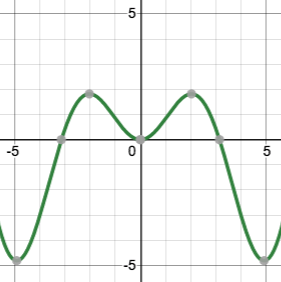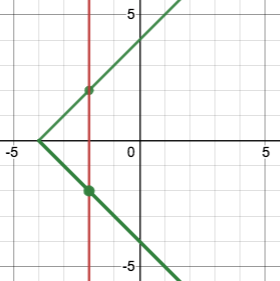(Also available in WeScheme)
Students learn to distinguish functions from other relations.
Lesson Goals |
Students will be able to:
|
Student-Facing Lesson Goals |
|
Materials |
|
Preparation |
|
- dependent variable
-
When modeling a relationship between an input and an output (e.g. - distance over time), we are curious about how a change in the input (typically graphed on the x-axis) impacts the output (y). When the output is entirely dependent on the input, we refer to the output as the "dependent variable".
- domain
-
the type or set of inputs a function expects, i.e., the independent variable(s) that govern the output of the function
- function
-
a relation from a set of inputs to a set of possible outputs, where each input is related to exactly one output
- graph
-
a diagram (such as a series of one or more points, lines, line segments, curves, or areas) that describes how one variable changes as the value of another (independent) variable changes.
- independent variable
-
When modeling a relationship between an input and an output (e.g. - distance over time), we are curious about how a change in the input (typically graphed on the x-axis) impacts the output (y). When the output is entirely dependent on the input, we refer to the input as the "independent variable".
- range
-
the type or set of outputs that a function produces, i.e., the dependent variable(s)
- vertical line test
-
a strategy for determining whether or not a graph represents a function by confirming that no vertical line can be drawn such that it would pass through 2 points on the plot. In a function, each x-value may only correspond to a single y-value.
🔗Functions Are Reliable 10 minutes
Overview
Students work collaboratively to generate visual representations of functions, using rules to make coordinate pairs.
Launch
Functions are a way of describing a certain kind of relationship.
Functions are reliable. If we give them what they need, they produce the same thing with that same collection of inputs every time.
You are already familiar with lots of relationships. Time worked is related to money earned. The speed of a car is related to the gas it consumes per miles driven. Not all relationships are functions. What kind of relationships are functions, exactly? That’s what we’re going to find out…
Investigate
Just as we can give the rectangle function inputs and it will produce an image, we can make graphs of functions by feeding inputs (x-values) into a rule that produces outputs (y-values). The resulting x-y pairs describe the location of points that will satisfy the rule. We can repeat the process with an infinite number of inputs, plotting the input-output pairs as a line or curve on a graph showing the relationship between the independent variable (x) and dependent variable (y).
-
On each slide of the Interactive Function Activity (Google), we’ll see a coordinate grid and a rule.
-
Each of you will choose an x-value that is within the domain of the graph, apply the rule to your x-value to get a y-value, and then place a dot on the graph whose coordinates are the 𝑥 you put in and the 𝑦 you got back.
-
When all of our dots appear on the screen together, we’ll end up with a visual representation of the function!
You might just want to do a few of these slides, or you might do lots of them.
Limitations of the Vertical Line Test Use of the vertical line test is contingent upon restricting ourselves to functions where the domain is composed of x-values and the range is composed of y-values. Once students are exploring questions about whether ‘x is a function of y’ (an important question for Algebra 2 students thinking about inverse functions), they will need to make use of other strategies. We recommend urging students to pay special attention to the domain and range of each function, noting that the domain is not necessarily the horizontal axis. |
Synthesize
-
How can we make a graph of a function from its rule?
-
Are there curves or lines that a function could not make? Why or why not?
🔗Identifying Functions from Graphs
Overview
Students learn to use the vertical line test to determine whether or not a graph is a function. Students have already seen all kinds of functions! The subset of functions that are Number->Number can be graphed in 2 dimensions, with the Domain along the x-axis and the Range along the y-axis. The Vertical Line Test is a special trick that only works for this subset of functions.
Launch
We can write functions that take in an x-value and produce a y-value. Different inputs can yield the same outputs. But each input can only be associated with one output.
We can test a graph to see whether or not it’s a function using the "vertical line test". Imagine overlaying a series of vertical lines on the graph. If the graph represents a function, none of the vertical lines will cross the graph at more than one point. If there is any vertical line that can be drawn that would intersect more than one point on the graph, it means the same input can have more than one output and the relationship is not a function.
Passes the Vertical Line Test -> Is a Function |
Fails the Vertical Line Test -> Is Not a Function |
|
|
Investigate
-
Turn to Identifying Functions from Graphs and use a straight edge and a pencil to draw vertical lines on each of the graphs to help you determine whether or not they are functions.
-
When you finish, go on to Identifying Functions from Graphs (2).
-
Once everyone has completed the first page, we will turn to Notice and Wonder - Functions.
As students work, circulate around the room and make sure that they are actually drawing vertical lines on the graphs. Some students may benefit from circling the point where each vertical line intersects the graph.
Synthesize
Confirm that students have correctly identified which graphs represent functions.
-
What did you Notice?
-
Functions could be lines, curves, v-shaped or scatterplots! Answers will vary.
-
-
What did you Wonder?
-
Why might some scatterplots represent functions and others not? Are there other forms that functions can take? How do you end up with a circle on a graph? Answers will vary.
-
🔗Identifying Functions from Tables
Overview
Students apply their understanding of how to use the vertical line test on graphs to learn to recognize whether or not tables are functions.
Launch
Turn to How Tables Fail the Vertical Line Test and follow the directions.
Circulate around the room verifying that students are remembering how to use the vertical line test and correctly identifying which tables represent functions.
-
How can we identify whether or not a table of values represents a function?
-
If a table has more than one y-value (or output) for the same x-value (or input), it cannot represent a function.
-
Investigate
-
Turn to Identifying Functions from Tables.
-
Look at the values in each table carefully to determine whether or not the table represents a function.
-
If it’s not a function, circle or highlight the points that let you know it can’t be a function.
-
When you’re done, turn to Notice and Wonder - Functions and add any new Notices or Wonderings you may have.
-
Then turn to Identifying Functions from Tables & Graphs.
As students work, circulate around the room and make sure that they are actually circling or highlighting the points on the tables that tell them that the table doesn’t represent a function.
Synthesize
Confirm that students have correctly identified which graphs represent functions, and then lead a discussion on the activities above.
-
What did you Notice?
-
Answers will vary. It can still be a function if y-values repeat. It didn’t matter whether or not the x-values followed a pattern. It was easier for me to read the tables when the x-values were in order.
-
-
What did you Wonder?
-
Answers will vary. Why weren’t the x-values always in order? If the points were on a graph, would they be connected? Can there ever be decimal values for x and y? What would these tables look like on a graph?
-
These materials were developed partly through support of the National Science Foundation, (awards 1042210, 1535276, 1648684, 1738598, 2031479, and 1501927).  Bootstrap by the Bootstrap Community is licensed under a Creative Commons 4.0 Unported License. This license does not grant permission to run training or professional development. Offering training or professional development with materials substantially derived from Bootstrap must be approved in writing by a Bootstrap Director. Permissions beyond the scope of this license, such as to run training, may be available by contacting contact@BootstrapWorld.org.
Bootstrap by the Bootstrap Community is licensed under a Creative Commons 4.0 Unported License. This license does not grant permission to run training or professional development. Offering training or professional development with materials substantially derived from Bootstrap must be approved in writing by a Bootstrap Director. Permissions beyond the scope of this license, such as to run training, may be available by contacting contact@BootstrapWorld.org.


